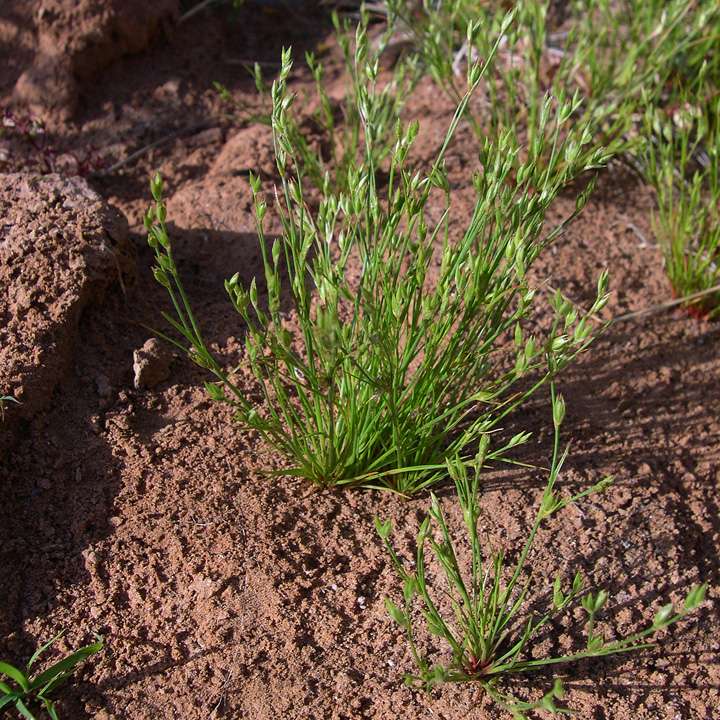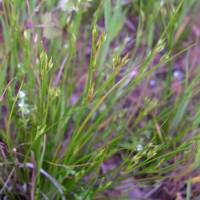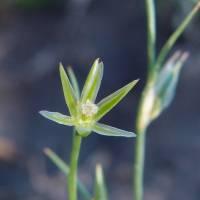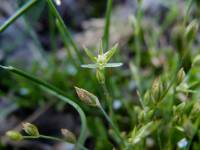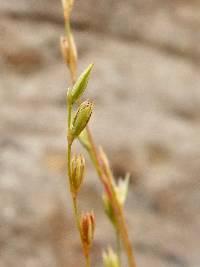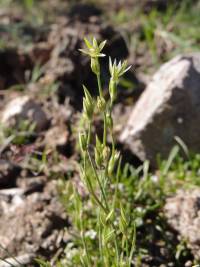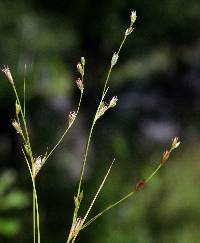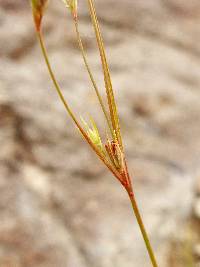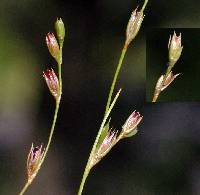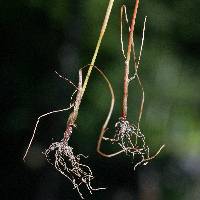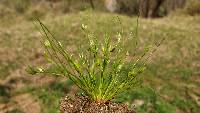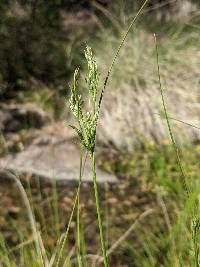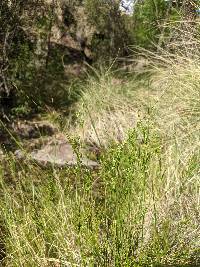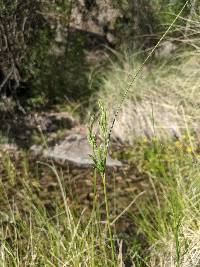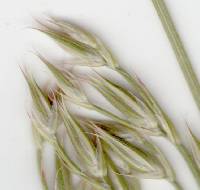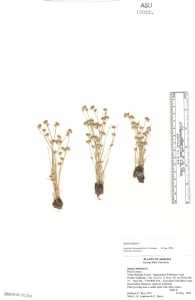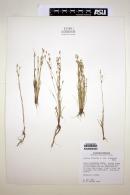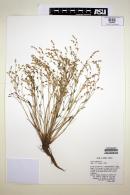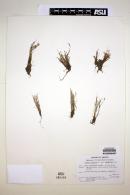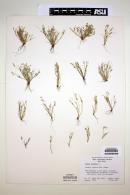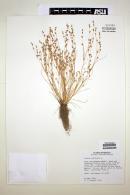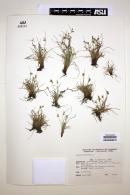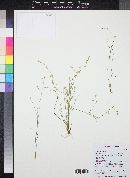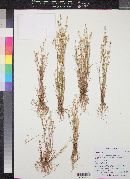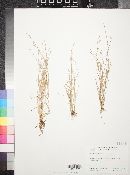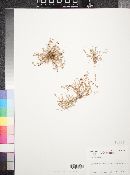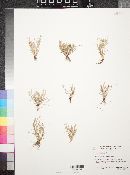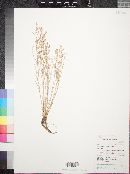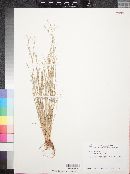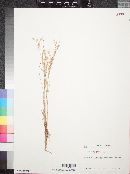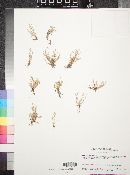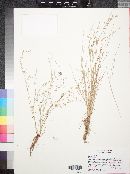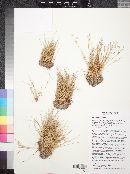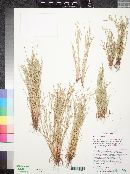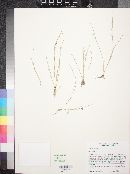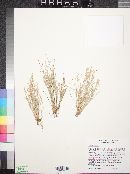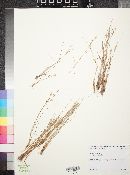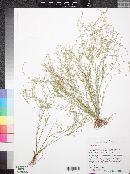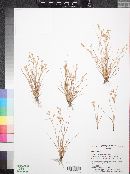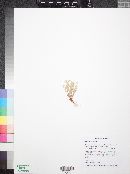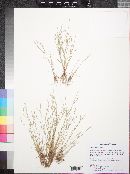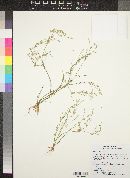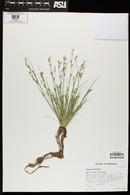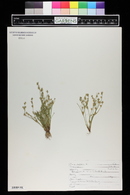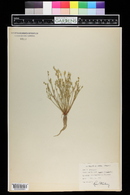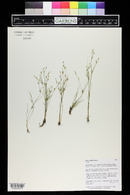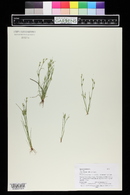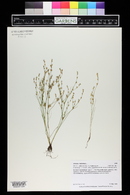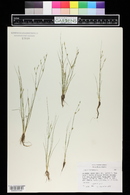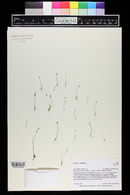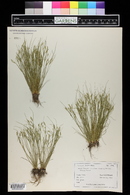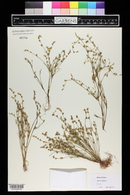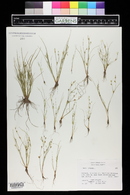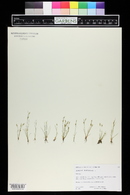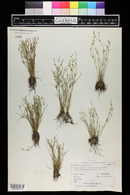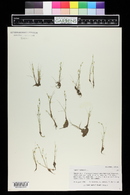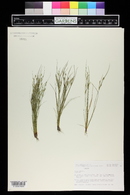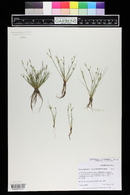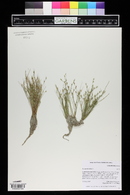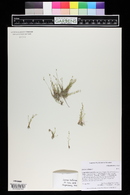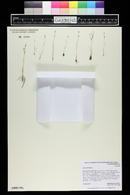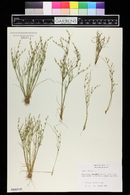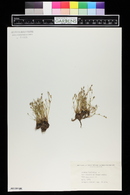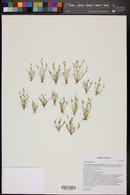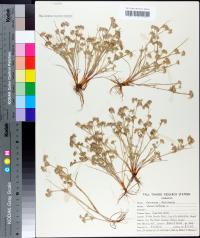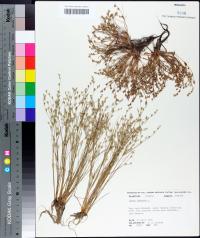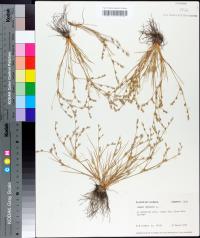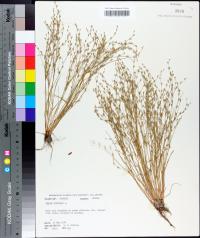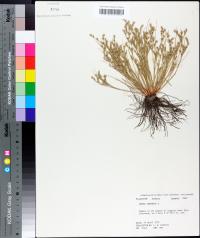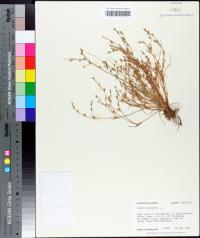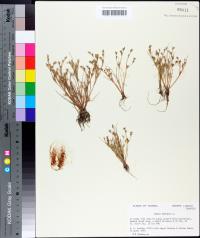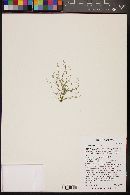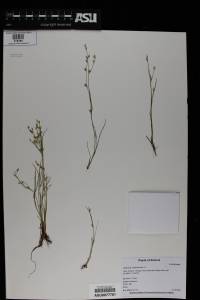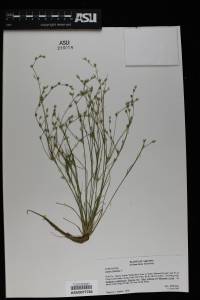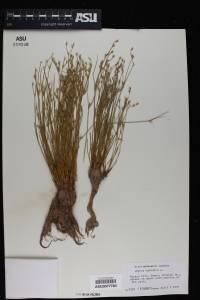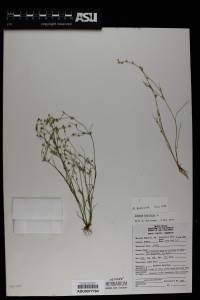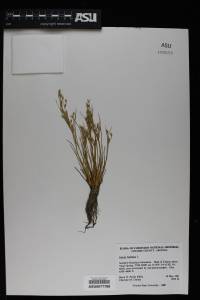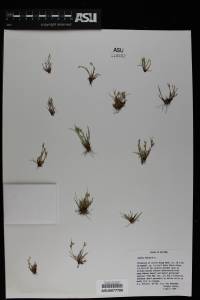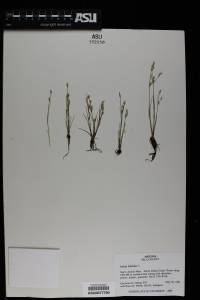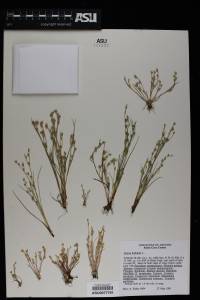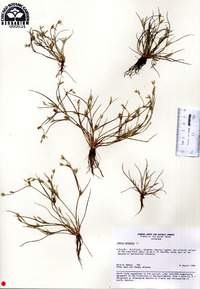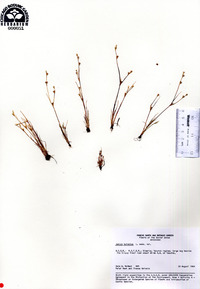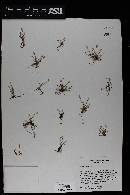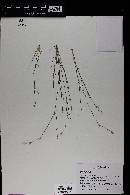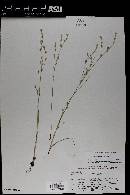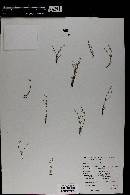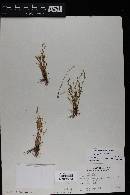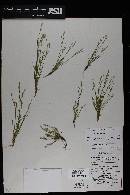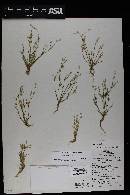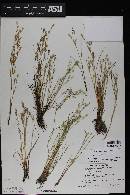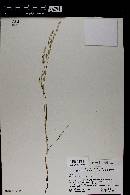Juncus bufonius
|
|
|
|
Family: Juncaceae
Toad Rush, more... (es: tulillo)
[Juncus bufonius var. fasciculatus W. D. J. Koch, moreJuncus bufonius var. juzepczukii] |
Herbs, annual, cespitose, 0.5--4 dm. Culms 1--many, occasionally becoming decumbent. Cataphylls 0--2. Leaves basal and cauline; auricles rudimentary or absent; blade flat, 3--13 cm x 0.3--1.1 mm. Inflorescences loose and diffuse or less often compact, usually at least ½ total height of plant; primary bract shorter than inflorescence. Flowers: bracteoles 2; tepals greenish, lanceolate, 3.8--7(--8.5) mm; inner series slightly shorter, apex sometimes obtuse; stamens 3--6, filaments (0.7--)1--1.8 mm, anthers 0.3--0.8 mm; style 0.1--0.2 mm. Capsules tan to reddish brown, 3-locular, ellipsoid to narrowly so, slightly truncate, 2.7--4 x 1--1.5 mm, sometimes exceeding inner tepals but usually not outer series. Seeds yellowish, widely ellipsoid to ovoid, 0.26--0.49, not tailed. 2n = 27--37, 58--81, 108--115. Flowering and fruiting spring--early fall. Moist soils in meadows, along lakeshores or stream banks, ditches, or roadsides, especially frequent in drawdown areas; usually in open sites and often becoming weedy; Greenland; Alta., B.C., Man., N.B., Nfld. and Labr., N.W.T., N.S., Ont., P.E.I., Que., Sask., Yukon; Ala., Alaska, Ariz., Ark., Calif., Colo., Conn., Del., D.C., Fla., Ga., Idaho, Ill., Ind., Iowa, Kans., Ky., La., Maine, Md., Mass., Mich., Minn., Miss., Mo., Mont., Nebr., Nev., N.H., N.J., N.Mex., N.Y., N.C., N.Dak., Ohio, Okla., Oreg., Pa., R.I., S.C., S.Dak., Tenn., Tex., Utah, Vt., Va., Wash., W.Va., Wis., Wyo.; nearly worldwide. Nearly worldwide, Juncus bufonius is found essentially throughout North America except north of the Alaskan and Canadian tTaiga. Juncus bufonius is a highly polymorphic complex that is poorly understood systematically. Insufficient evidence exists upon which to base the segregation of the plethora of taxa that have been recognized out of this group in the past.
Annual grasslike forb 5 - 40 cm tall Leaves: few to several, both basal and alternate on stem, 3 - 13 cm long, 0.3 - 1.1 mm wide, linear, grasslike, flattened in cross section, without crosswise partitions inside (non-septate), as well as lacking ear-like appendages (auricles) at the top of the leaf sheaths. Inflorescence: a terminal, relatively elongate (at least half the total height of plant), loose and widely spreading, branched structure with several, single, short-stalked, radially symmetric, small flowers scattered along the branches. The entire branched inflorescence is subtended by a bract (usually shorter than full inflorescence), and the individual short-stalked flowers have two small (1 - 2.5 mm) bracts (bracteoles) positioned directly below the tepals. Stamens: three to six, with 0.7 - 1.8 mm long filaments, and usually shorter anthers (0.3 - 0.8 mm). Pistil: with one superior ovary, a 0.1 - 0.2 mm long style, and three stigmas. Fruit: three-chambered, tan to reddish brown, 2.7 - 4 mm tall (rarely longer than outer tepals), 1 - 1.5 mm wide, narrowly ellipsoid, fairly blunt-tipped capsules. Stems: tufted, ascending or sometimes more decumbent, round in cross section, and arising from fibrous roots. Seeds: many, yellowish, 0.26 - 0.49 mm long, widely ellipsoid to egg-shaped with short-pointed or abruptly narrowed tips, but without distinct narrowed tails at the ends. Tepals: six in two whorls of three, greenish with transparent or membranous edges, 3.8 - 8.5 mm long (outer three slightly longer than inner three), lance-shaped, sometimes with blunt tips. Similar species: Juncus bufonius is quite unique due to its annual life cycle, fibrous roots instead of rhizomes, relatively small size (often under 10 cm), and the absence of ear-like appendages (auricles) at the top of the leaf sheaths. Although superficially J. marginatus may appear similar, it differs by having knotted rhizomes, always only three stamens, and the flowers are grouped in small clusters. Species in the same subgenus as J. bufonius (i.e. subgenus Poiophylli) differ because they are perennials, typically taller than 10 cm (with much shorter inflorescences compared to the total plant height), and some either have obvious small ear-like appendages (auricles) at the summits of the leaf sheaths, while others have leaf blades that are nearly round in cross section. Flowering: June to September Habitat and ecology: Occasional, typically in wet sands or silty soils, especially on pond shores, but also in compacted soils along paths or in vehicle tracks. Occurence in the Chicago region: native Notes: This is the only annual species of Juncus in our area. In the Chicago Region, this plant is consistently less than 15 cm tall. Author: The Field Museum FNA 2000, Balslev 1996 Common Name: toad rush Duration: Annual Nativity: Native Lifeform: Graminoid General: Caespitose annual, 5-40 cm tall, no rhizomes. Vegetative: Culms erect, procumbent or ascending, terete, smooth, 0.5-1.5 mm in diameter, with foliar shoots in leaf axils, cataphylls absent to rarely one, membranous 7-12 mm long; foliar leaves 1-5 basal and 1-3 cauline to each stem, 4-15 cm long, scariose margins Inflorescence: Usually more than half the total plant height, compound, several unilateral cymes with flowers inserted individual and removed from one another, rarely 2-4 flowers clustered together; lower inflorescence bract resembling cauline leaf, 4-15 cm long, distal bracts progressively shorter, ultimate ones 5 mm long and scarious; 2 bracteoles, greenish tepals, lanceolate 3.5-7 mm, inner series slightly shorter, apex sometimes obtuse; capsule ellipsoid, three sided, truncate and mucronate, 3-4 mm by 1.5-2 mm with persistent style 0.1-0.3 mm long. Ecology: Found in moist soils along meadows, stream banks, roadsides, usually in open sites. Widespread, weedy species; flowers early spring to fall. Notes: Very cosmopolitan species that is also highly polymorphic. Ethnobotany: Taken as an emetic, and used as a body wash. Etymology: Juncus comes from the Latin jungere, to join or bind, while bufonius pertains to toads, or refers to the habit of growing in moist places. Synonyms: None Editor: SBuckley, 2010 Annual to 3 dm, the stems terete, sometimes branched; lvs basal and usually also cauline, capillary, 0.5-10 cm נ0.2-1.1 mm, convex on the lower surface, flat or channeled on the upper; fls often cleistogamous, scattered singly along the upper part (often more than half) of the stem, short-pedicellate or subsessile in the axils of hyaline-scarious or partly leafy bracts, each one also closely subtended by a pair of broad, hyaline-scarious bracteoles 1-2.5 mm; tep slender, with greenish midstrip and hyaline margins, mostly 3-6 mm, the outer a little the longer; anthers 6, 0.3-1 mm, up to as long as the filaments; style very short, fr imperfectly trilocular; seeds 0.3-0.6 mm, apiculate; 2n=26-120, a small polyploid pillar-complex. Moist or vernally wet or moist places; nearly cosmopolitan, and throughout our range. Most of our plants are polyploid and have acuminate pet slightly longer than the fr. A ±diploid halophytic phase, found in salt-marshes along the coast from Lab. to Mass., and widespread in Europe, differs morphologically from typical, widespread J. bufonius in its consistently small size (rarely to 15 cm) and obtuse or mucronate pet equaling or slightly shorter than the fr. This phase has been segregated as var. halophilus Fernald or J. ambiguus Guss. Gleason, Henry A. & Cronquist, Arthur J. 1991. Manual of vascular plants of northeastern United States and adjacent Canada. lxxv + 910 pp. ©The New York Botanical Garden. All rights reserved. Used by permission. From Flora of Indiana (1940) by Charles C. Deam Common on sandy or clay roadsides and abandoned roads in open woods or marshes; frequent on low sandy lake shores, in ditches, sandy swales, and low fallow fields. …… Indiana Coefficient of Conservatism: C = 2 Wetland Indicator Status: FACW |
|
|
|

